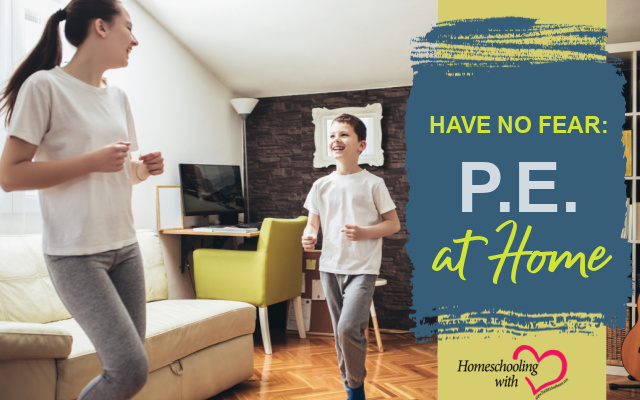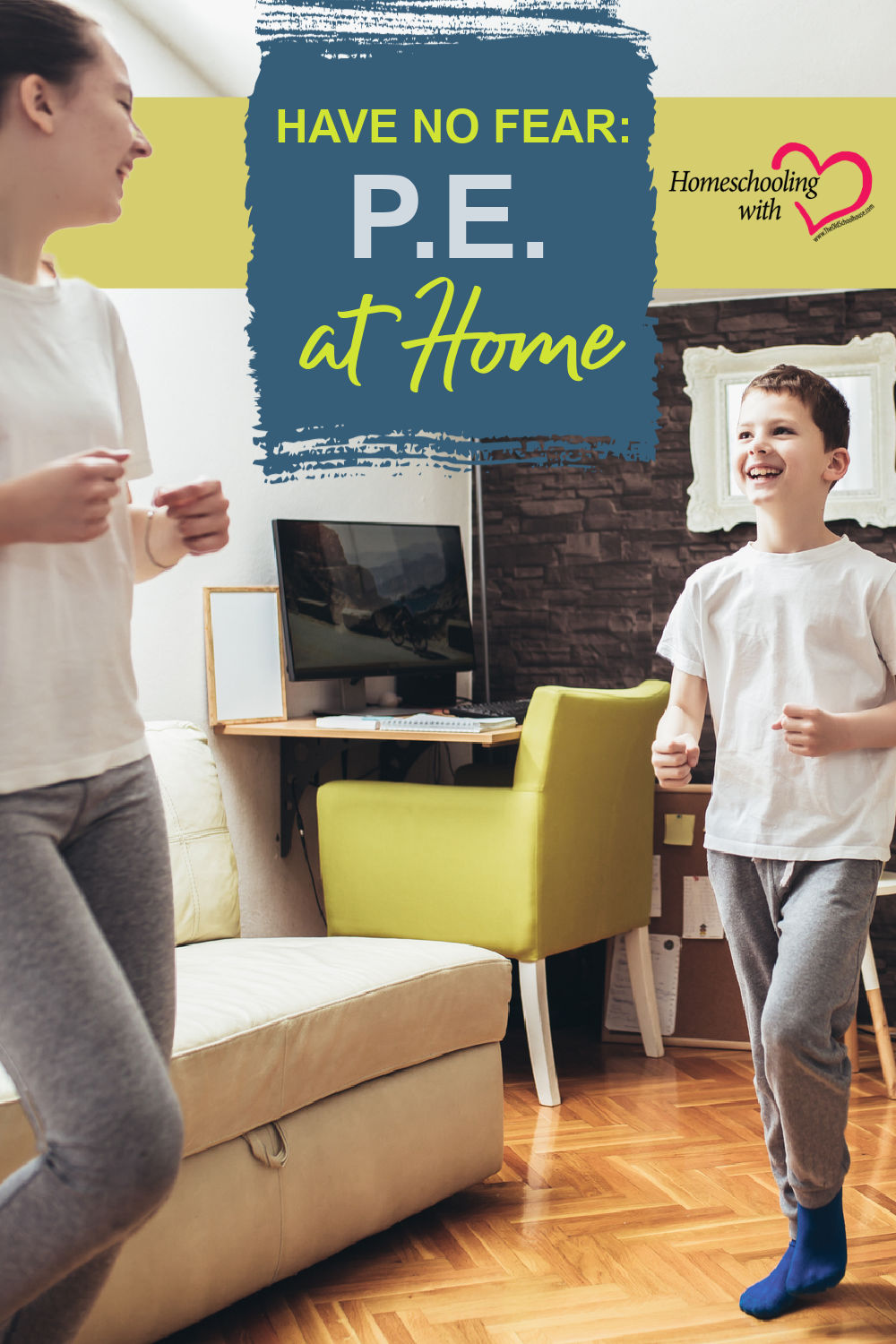Have No Fear: P.E. at Home


After high school math and science, I’ve found many homeschoolers worry about physical education requirements. I think it may be because some of us had horrid experiences or think back to the organization of P.E. classes. We don’t want to repeat the former and don’t know how to do the latter.
The National Association for Sports & Physical Education (NASPE) recommends all children need at least sixty minutes of moderate-to-vigorous activity a day. Not a bad idea for adults either.
Let’s take a moment to look at the term here—physical education. According to Merriam-Webster Unabridged Dictionary, this means “instruction in the development and care of the body.” The definition goes on to say P.E. can include calisthenics, performance and management of athletic games, and the study of hygiene. The physical movement not only exercises the muscles of the body, it also provides a “brain break.” These breaks allow the brain to rest and restore. Even moderate activity provides a fresh supply of oxygen to the brain.
NASPE cites advantages other than movement and restoration. A less obvious benefit is learning ethical traits. The training needed even for what is considered simple activities, riding a bike for instance, requires perseverance to continue. While learning a new activity, failure will happen. Our kids learn failure is not bad and to use it as a stepping-stone to learn more. Learning a new activity may also require a work ethic to be able to stick to it day after day.
A P.E. program doesn’t need to be an organized class or a team sport. It can be what children do without teams or organization. Riding bicycles or skateboarding, jumping rope, playing hopscotch, and climbing trees are all activities that can qualify as the physical exercise needed.
We often don’t think about P.E as when sweeping the floor, mowing the yard, and bringing in the groceries. Each of these builds muscle and can be as vigorous as other exercises. These undertakings may also teach needed discipline to do a task we may not enjoy.
Do you need to keep a time record of your kids’ activities? Unless the state or school requires a specific number of minutes or hours, I don’t think so. Since children taught at home aren’t sitting at desks for six hours during the day, they are already more active. Watch your quiet ones though. The kiddo who would rather read a novel needs to get off the couch as well.
What can you do for your P.E. program?
Housework Olympics
Add a time element to certain chores, such as sweeping or vacuuming. Either have each child try to beat a previous time or beat parents at the task. Put the times on a chart on the refrigerator, and at the end of a month have a special meal for the winner. Not only will you and your children get a workout, but ordinary chores won’t be quite so dull. Just imagine the children saying, “Can I sweep the kitchen now?”
Don’t forget the outside chores as well. Pulling weeds, raking leaves, and washing the car can all be fun exercise when a little competition is added. My children got plenty of running exercise while chasing each other with the hose during family car washing session.
Rough Housing
We parents continue the long-held tradition of no rough housing, especially in the house. All three of my children thought the greatest fun was wrestling with dad in the living room. We didn’t have a table in the middle of the floor, and all breakables were put up somewhere safe. These matches usually led to a game of chase. The kitchen was off limits though because this P.E. class usually took place while I was cooking dinner. With dad’s supervision, even the youngest member of the family could take part safely.
Homeschool Disco
Our family enjoys a wide variety of music. During the afternoon, we would often gather in the living room just to jump and dance to whatever was playing. If the music had words, someone would come up with “dance steps” to tell the story being sung.
Exercise Videos
One time, I thought we needed more organized exercising so I got a Dancing to the Oldies video. It was to be forty minutes of aerobic exercise with Richard Simmons. The ensuing laughter each time we used it was enough vigorous activity to qualify for the twenty minutes required by our state.
There are a number of video exercise programs streaming on the internet to suit any taste and style. These will help you make sure that the children are getting all the basic type of exercise needed.
Want to make the exercise video more fun? Create your own. Have your children select the music and create exercise routines. Follow standard patterns of warm-up, exercise, and cool down. Use a commercial video as an example.
Backyard Training Camp
For children who are in organized sports, training drills can be done at home as well as on the practice field. Books, tapes, and websites offer enough individual drill to keep you busy for the entire season. Include teaching the game’s rules, strategy, and sportsmanship at the same time. I know every youth baseball coach is deeply indebted to a parent who explains in-field fly rule to their child, and anyone who can understand soccer’s off side rule will be enshrined in the youth sports hall of fame.
Mathercise
Do jumping jacks, sit-ups, or jump rope while repeating math facts. Or walk in rhythm to repeating the multiplication tables or addition tables.
Out of the ordinary
Learn new things. Did you ever really get the hang of the hoola-hoop? It’s not too late to learn this “skill” along with your children. Instead of just juggling an over-busy schedule, learn to juggle balls. If nothing else, chasing wayward balls will get everyone plenty of exercise. Or how about a pogo stick?
Not so ordinary
Bicycle riding, swimming, croquet, badminton, games of hide-n-seek, and tag are all good exercise which are so common we don’t think about them as part of a P.E. program. During the winter months, take time for sledding, building a snowman, and a snowball fight.
Physical Education class needn’t be a chore or even a class for that matter. The important part is for everyone to get up and move.
NASPE has lists of breaks and exercises at https://www.aasa.org/uploadedFiles/Resources/files/NASPEPhysicalActivity.pdf.
Susan K. Stewart, Nonfiction Managing Editor with Elk Lake Publishing, teaches, writes, and edits non-fiction. Susan’s passion is to inspire readers with practical, real-world solutions. Her books include Science in the Kitchen, Preschool: At What Cost?, Harried Homeschoolers Handbook, and the award-winning Formatting e-Books for Writers. Her latest book, Donkey Devos: Listening to you donkey when God speaks, is scheduled to be released spring 2021. You can learn more at her website www.practicalinspirations.com.













































